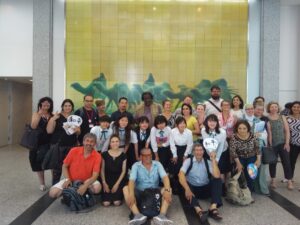
The Oleander Initiative gathers educators from communities around the world to work together and transform the lessons of Hiroshima into relevant and impactful peace education activities for their students. The Oleander Initiative generates deep awareness of the catastrophic humanitarian impacts of nuclear weapons and equips participants with intellectual tools for conflict resolution and mutual understanding.
During early August in 2016 and 2017, educators from the Middle East, North Africa, Japan and the US gathered together during the anniversary of the atomic bombing of Hiroshima, today a vibrant metropolis known as the City of Peace. During the program, Oleander educators developed lesson plans for their students informed by interactions with atomic bomb survivors, schoolteachers from the city of Hiroshima, and from experts on the humanitarian impact of nuclear war. These lesson plans — fine-tuned and co-developed with Oleander staff and fellow participants during the program — have a concrete and tangible impact on their students and communities. They raise consciousness about the catastrophic global impacts of nuclear war and inspire our next generation to work locally to promote peaceful societies.
The Oleander Initiative gathers educators from communities around the world to work together and transform the lessons of Hiroshima into relevant and impactful peace education activities for their students. The Oleander Initiative generates deep awareness of the catastrophic humanitarian impacts of nuclear weapons and equips participants with intellectual tools for conflict resolution and mutual understanding.
During early August in 2016 and 2017, educators from the Middle East, North Africa, Japan and the US gathered together during the anniversary of the atomic bombing of Hiroshima, today a vibrant metropolis known as the City of Peace. During the program, Oleander educators developed lesson plans for their students informed by interactions with atomic bomb survivors, schoolteachers from the city of Hiroshima, and from experts on the humanitarian impact of nuclear war. These lesson plans — fine-tuned and co-developed with Oleander staff and fellow participants during the program — have a concrete and tangible impact on their students and communities. They raise consciousness about the catastrophic global impacts of nuclear war and inspire our next generation to work locally to promote peaceful societies.
Please click HERE to view a photo report of the 2016 Oleander Initiative
he University of the Middle East Project (UME) builds bridges through education among societies and cultures in the Middle East, North Africa, North America and Europe.